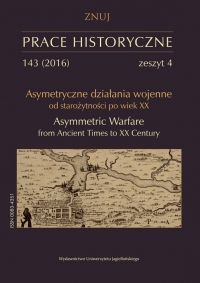Galijska katastrofa pod Telamonem w 225 roku p.n.e. – aspekt militarno-psychologiczny
The Gallic disaster at Telamon in 225 BC: the military and psychological aspect
Author(s): Bronisław SzubelakSubject(s): Archaeology, Ancient World
Published by: Wydawnictwo Uniwersytetu Jagiellońskiego
Keywords: chariots; Gaesatae; charge; naked; javelins
Summary/Abstract: The Celtic tribes migrated into Northern Italy in the late 8th and 7th centuries BC. In 390 BC the Gauls sacked the city of Rome. The Romans believed that they would never be safe while the Gauls threatened their northern frontier, so they colonized the land in the northern part of Picenum in 232 BC. In 225 BC, a huge Gallic army swarmed southwards through Etruria. Some 50,000 infantry and 20,000 cavalry and chariots drawn from the Cisalpine Boii, Insubres, Taurisci and Transalpine Gaesatae plundered the region and annihilated the Roman forces at Clusium, 3 days of march north of Rome. At Telamon, however, they were intercepted by two Roman forces (8 legions and allies), approaching them from two opposite directions. The Gauls were forced to deploy their army facing both ways. The line facing rearward, anticipating Aemilius, had the Gaesatae in front and the Insubres behind them. Facing the opposite direction, ready to meet Atilius, were the Taurisci and Boii. Gaesatae (probably javeleeners) fought naked, standing proudly in front of the whole army with nothing but their weapons to protect them. The Insubres and Boii, by contrast, wore trousers and cloaks. The strength of a Gallic attack lay in the first onslaught, its power fuelled by the belief in a glorious afterlife, the desire for fame, and some hysteria fuelled by noise and chanting, and often enhanced by alcohol. Such charges lacked focus and, if repulsed, the Gauls had no strategy for recovery and became desperate. The Roman light infantry javelins inflicted heavy damage on the naked Gaesatae. The Roman maniples armed with a pila, a heavy javelin designed to penetrate the target’s shield, and a gladius, a short stabbing sword, attacked the Insubres, Boii and Taurisci. The Gauls were finally defeated when they were attacked on their flank by the Roman cavalry. The Gallic infantry were cut to pieces, and the cavalry fled. Polybius reports that 40,000 Gauls were killed in the battle. The Battle of Telamon was the last recorded use of chariots in a battle on the European continent. During the 3rd century BC, the cavalry became more significant in Gallic warfare. After this battle, Gallic cavalry would serve as mercenary troops for foreign armies.
Journal: Prace Historyczne
- Issue Year: 144/2017
- Issue No: 3
- Page Range: 427-439
- Page Count: 13
- Language: Polish

